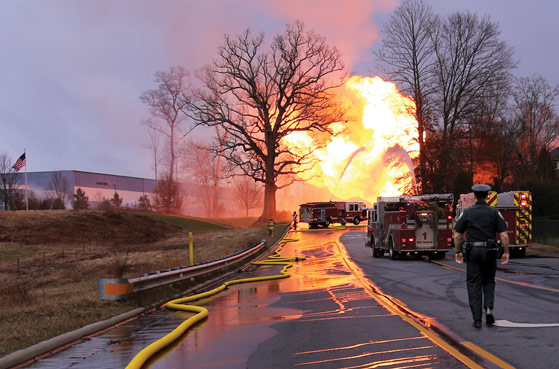| Trouble viewing this email? Click here. |
 |
|
Welcome to National Grid’s Tips of the Trade for first responders. These tips are intended to help you respond safely and effectively to incidents involving natural gas and electricity. Please review them with your team.
|
|
| Responding to natural gas transmission pipeline emergencies |
| Natural gas transmission pipelines transport large volumes of gas at high pressure across long distances, so leaks in these pipelines can produce very large and dangerous fires and explosions. Although transmission pipeline incidents are rare, they can present some of the most challenging situations first responders may encounter, so being prepared is important. |
 |
| Fortunately, responding to an incident involving a natural gas transmission pipeline follows many of the same principles as responding to a smaller distribution pipeline leak. However, the increased volume and higher gas pressure combine to magnify the scope and complexity of a transmission pipeline incident. |
| What are the challenges? |
| • |
 |
The transmission pipeline may not be managed by National Grid, so you may be working with an unfamiliar operator. |
|
| • |
 |
Gas in transmission pipelines typically lacks odorant, making it more difficult to detect. Use of a combustible gas indicator (CGI) is essential. |
|
| • |
 |
There are limited options to stop the release of gas, and you will need to coordinate with the pipeline operator to resolve the incident safely. |
|
| • |
 |
Even after the pipeline valve is closed, gas can continue to flow at the same rate for a considerable time. |
|
| • |
 |
Large quantities of gas can collect inside multiple buildings and confined spaces, presenting a high risk of fire, explosion and asphyxiation. |
|
|
| Response strategies |
| 1. |
 |
Make sure your dispatcher informs National Grid or the transmission pipeline operator of the event and requests appropriate assistance. |
|
| 2. |
 |
Upon arrival, assess the scene and confirm the pipeline location and fuel. |
|
| 3. |
 |
Work together with other responders to stay out of harm’s way and secure the area. |
|
| 4. |
 |
Protect the public through a combination of rescue, evacuation and sheltering in place. |
|
| 5. |
 |
Integrate the pipeline operator’s emergency management personnel into your Incident Command structure. Work together to control the situation and mitigate damage. |
|
| 6. |
 |
If ignition has not occurred, eliminate potential ignition sources. Use intrinsically safe radios and flashlights for the duration of the response. |
|
| 7. |
 |
Do NOT attempt to extinguish a pipeline fire as long as gas is leaking. Instead, cool combustible exposures. |
|
|
|
| For more first responder safety information, visit firstresponder.ngridsafety.com. |
|
|
|
| |
| |
|
| To report emergencies, call 911 and National Grid immediately. |
| |
 |
| In case of gas emergencies: |
 |
Long Island and the Rockaways:
911 and 1-800-490-0045 |
 |
Metro New York:
911 and 1-718-643-4050 |
 |
Upstate New York:
911 and 1-800-892-2345 |
 |
Massachusetts:
911 and 1-800-233-5325 |
 |
Rhode Island:
911 and 1-800-640-1595 |
|
|
|
|
| |
|
|
|
| |
| |
|
 |
#12408 © 2021 Culver Media, LLC |
|
| |
|
|
|
 |
|
|